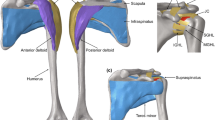Abstract
Most musculoskeletal injuries occur during the work routines in different areas, due to repetitive and sustained movements, they are often located in the shoulder. For workers in the building sector, the repetitive movements and displacements occur under load and unnatural postures of the shoulder joint. For this reason, this study aims to model in 3D the biological components which form the shoulder joint for the later finite element analysis. Three cases with different loads have been considered for this study. Due to a linear and isotropic joint approach it has been possible to evaluate the tensions in the main components of the shoulders: muscles, tendons and ligaments. The methodology used allowed obtaining an improved mesh of the shoulder joint to analyse real situations with finite element method analysis with applications in the field of sports medicine, work, etc. Furthermore, the simplification adopted for modelling the joint muscles, as 1D elements in the finite element model has made it possible to establish different positions of human joint without mesh again each of the studied positions. The results are consistent with the states of applied loads. In fact, the maximum stresses in bones are in the insertion areas of the ligaments. Due to the static positions of the joint under study, the muscles do not support high stresses. According to the stresses distribution, the maximum values are in the zones of tendons. From the result analysis, it is observed how the stresses distribution in the cartilage area maintains coherence with reality since the maximum stresses appear in the lower half of the cartilage. In this area in which the Humerus-scapula contact is greater, the compression tensions are greater.































Similar content being viewed by others
References
Brunelli, M. P., and Gill, T. J., Fractures and tendon injuries of the athletic shoulder. Orthop. Clin. North Am. 33(3):497–508, 2002.
Islan, M., Carvajal, J., Pedro, P. S., D’Amato, R., Juanes, J. A., and Soriano, E., Linear approximation of the behavior of the rotator cuff under fatigue conditions. Violinist case study, in Proceedings of the 5th International Conference on Technological Ecosystems for Enhancing Multiculturality - TEEM 2017, pp. 1–8, 2017.
M. Islan, F. Blaya, P. San Pedro, R. D’Amato, E. Lechosa Urquijo, and J. A. Juanes, “Analysis and fem simulation methodology of dynamic behavior of human rotator cuff in repetitive routines: Musician case study,” J. Med. Syst., vol. 42, no. 3, 55, 2018.
CDC - NIOSH Publications and Products, Cumulative trauma disorders in the workplace (95-119), DHHS Publ. Number 95–119, 1995.
International Labour Office - Geneva, LIST OF OCCUPATIONAL DISEASES (revised 2010) Identification and recognition of occupational diseases: Criteria for incorporating diseases in the ILO list of occupational diseases. Geneva: INTERNATIONAL LABOUR OFFICE • GENEVA, 2010.
Ruggiero, A., Affatato, S., Merola, M., and De, M. C., FEM analysis of metal on UHMWPE total hip prosthesis during normal walking cycle, in Proceedings of the XXIII Conference of the Italian Association of Theoretical and Applied Mechanics (AIMETA 2017), pp. 4–7, 2017.
Ruggiero, A., Gòmez, E., and D’Amato, R., Approximate analytical model for the squeeze-film lubrication of the human ankle joint with synovial fluid filtrated by articular cartilage. Tribol. Lett. 41(2):337–343, 2011.
Ruggiero, A., Gómez, E., and D’Amato, R., Approximate closed-form solution of the synovial fluid film force in the human ankle joint with non-Newtonian lubricant. Tribology International 57:156–161, 2013.
D’Amato, R., Calvo, R., and Gómez, E., Sensitivity study of the morphometric fitting on the pressure field inside ankle joints. Case Stud. Mech. Syst. Signal Process. 1:8–14, 2015.
Luo, Z. P., Hsu, H. C., Grabowski, J. J., Morrey, B. F., and An, K. N., Mechanical environment associated with rotator cuff tears. J. shoulder Elb. Surg. 7(6):616–620, 1998.
Seki, N. et al., Mechanical environment of the supraspinatus tendon: Three-dimensional finite element model analysis. J. Orthop. Sci. 13(4):348–353, 2008.
Zheng, M., Zou, Z., Bartolo, P. J. D. S., Peach, C., and Ren, L., Finite element models of the human shoulder complex: a review of their clinical implications and modelling techniques, International Journal for Numerical Methods in Biomedical Engineering, vol. 33, no. 2. Wiley-Blackwell, 2017.
Author information
Authors and Affiliations
Corresponding authors
Ethics declarations
Conflict of interest
Manuel Islán Marcos declares that he has no conflict of interest. Emilio Lechosa Urquijo declares that he has no conflict of interest. Fernando Blaya Haro declares that he has no conflict of interest. Roberto D’Amato declares that he has no conflict of interest. Enrique Soriano Heras declares that he has no conflict of interest. Juan Antonio Juanes declares that he has no conflict of interest.
Ethical approval
This article does not contain any studies with human participants performed by any of the authors. This article does not contain any studies with animals performed by any of the authors.
Additional information
Publisher’s Note
Springer Nature remains neutral with regard to jurisdictional claims in published maps and institutional affiliations.
This article is part of the Topical Collection on Education & Training
Rights and permissions
About this article
Cite this article
Islán Marcos, M., Lechosa Urquijo, E., Blaya Haro, F. et al. Behavior under Load of A Human Shoulder: Finite Element Simulation and Analysis. J Med Syst 43, 132 (2019). https://doi.org/10.1007/s10916-019-1248-y
Received:
Accepted:
Published:
DOI: https://doi.org/10.1007/s10916-019-1248-y




